#export and import of samples
Explore tagged Tumblr posts
Video
youtube
youtube Liven Lo Fi 12 Tutorial
0 notes
Text
US rice exports to Haiti, which account for the bulk of supplies of the country’s key food staple, contain unhealthy levels of arsenic and cadmium, heavy metals that can increase risks of cancer and heart disease, according to a recent study by the University of Michigan.
Haiti is among America’s top buyers of rice, alongside Mexico and Japan, and cheap imports are more affordable than local options in the Caribbean nation, the poorest state in the western hemisphere.
According to the study, average arsenic and cadmium concentrations were nearly twice as high in imported rice compared to the Haitian-grown product, with some imported samples exceeding international limits.
Nearly all imported rice samples exceeded the US Food and Drug Administration’s recommendation for children’s consumption. [...]
The study, which attributed the dominance of imported rice to lower import tariffs and long-term contracts signed during [US-supported] political turmoil in the late 1980s and 1990s, said Haiti imports nearly 90 per cent of its rice, almost exclusively from the US.[...]
When researchers ran the study in 2020, they found that Haitians on average consumed 85kg of rice per year, compared to 12kg in the US
23 Feb 24
2K notes
·
View notes
Text

Sample finished design found on Nintendo's official page for Mario no Photopi in 1998, featuring a Yoshi from Yoshi's Story.
Mario no Photopi was a Japanese-only Nintendo 64 title, functioning similar to Mario Paint with an ability to draw and edit images, with an additional ability to import and export image files via a proprietary memory card system.
Main Blog | Patreon | Twitter | Bluesky | Small Findings | Source
689 notes
·
View notes
Text
Egypt import-export data
Exim Trade data is providing you with an in-depth market analysis report on Egypt import-export data. We allow our users to access customized import-export data as per their requirements. They can explore the African country's data with visual graphs for a better understanding of the data. You can check out the sample of import export data of Egypt by clicking the below link - https://eximtradedata.com/egypt-import-export-data
#egypt customs data#egypt shipment data 2021#egypt trade data 2021#egypt imports by country#egypt exports by country#egypt imports exports by country#egypt import export data statistics 2021#egypt import export data 2022#egypt import export database#egypt top exports#egypt top imports#egypt top product exports#egypt top product imports#egypt top imported hs codes#egypt top export hs codes#egypt import-export sample data#egypt buyers data#egypt sellers data#egypt suppliers data#customs data of egypt
0 notes
Text
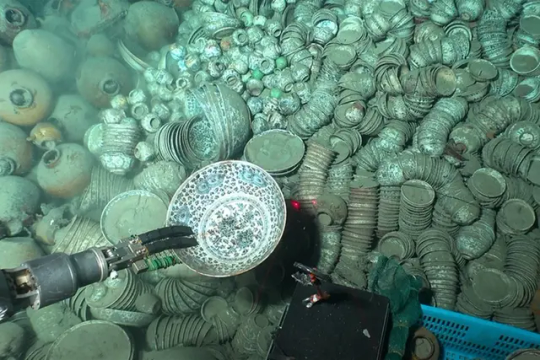
900 Artifacts From Ming Dynasty Shipwrecks Found in South China Sea
The trove of objects—including pottery, porcelain, shells and coins—was found roughly a mile below the surface.
Underwater archaeologists in China have recovered more than 900 artifacts from two merchant vessels that sank to the bottom of the South China Sea during the Ming dynasty.
The ships are located roughly a mile below the surface some 93 miles southeast of the island of Hainan, reports the South China Morning Post’s Kamun Lai. They are situated about 14 miles apart from one another.

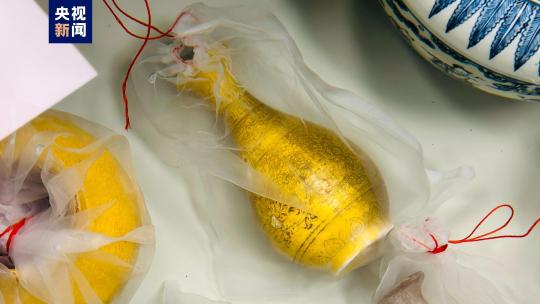
During three phases over the past year, researchers hauled up 890 objects from the first vessel, including copper coins, pottery and porcelain, according to a statement from China’s National Cultural Heritage Administration (NCHA). That’s just a small fraction of the more than 10,000 items found at the site. Archaeologists suspect the vessel was transporting porcelain from Jingdezhen, China, when it sank.
The team recovered 38 items from the second ship, including shells, deer antlers, porcelain, pottery and ebony logs that likely originated from somewhere in the Indian Ocean.
Archaeologists think the ships operated during different parts of the Ming dynasty, which lasted from 1368 to 1644.
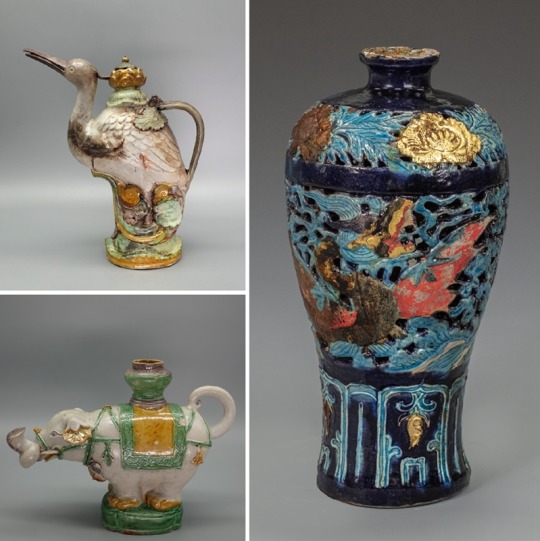
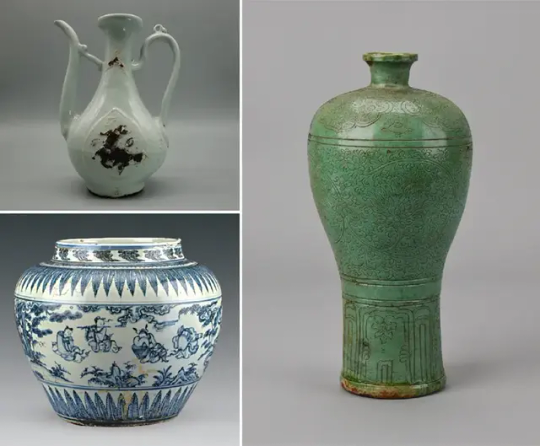
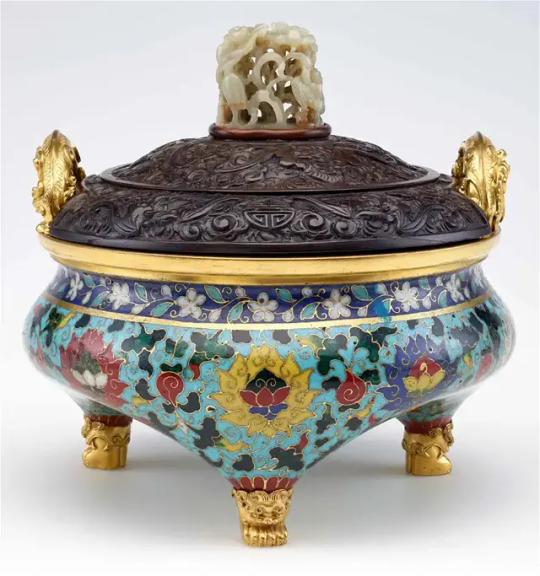
Many of the artifacts came from the Zhengde period of the Ming dynasty, which spanned 1505 to 1521. But others may be older, dating back to the time of Emperor Hongzhi, who reigned from 1487 to 1505, as Chris Oberholtz reported last year.
Archaeologists used manned and unmanned submersibles to collect the artifacts and gather sediment samples from the sea floor. They also documented the wreck sites with high-definition underwater cameras and a 3D laser scanner.
The project was a collaboration between the National Center for Archaeology, the Chinese Academy of Science and a museum in Hainan.
“The discovery provides evidence that Chinese ancestors developed, utilized and traveled to and from the South China Sea, with the two shipwrecks serving as important witnesses to trade and cultural exchanges along the ancient Maritime Silk Road,” says Guan Qiang, deputy head of the NCHA, in the agency’s statement.
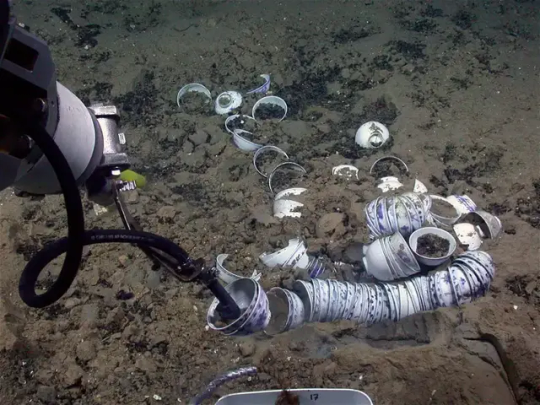
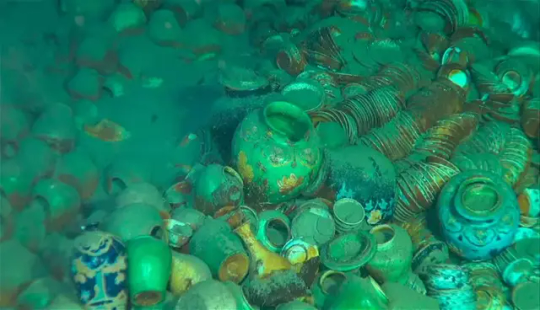
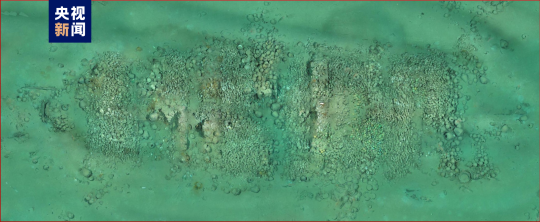
During the Ming dynasty, China’s population doubled, and the country formed vital cultural ties with the West. Ming porcelain, with its classic blue and white color scheme, became an especially popular export. China also exported silk and imported new foods, including peanuts and sweet potatoes.
The period had its own distinctive artistic aesthetic. As the Smithsonian’s National Museum of Asian Art writes, “Palace painters excelled in religious themes, moralizing narrative subjects, auspicious bird-and-flower motifs and large-scale landscape compositions.”
The shipwreck treasures aren’t the only recent discoveries in the South China Sea, according to CBS News’ Stephen Smith. Just last month, officials announced the discovery of a World War II-era American Navy submarine off the Philippine island of Luzon.
By Sarah Kuta.

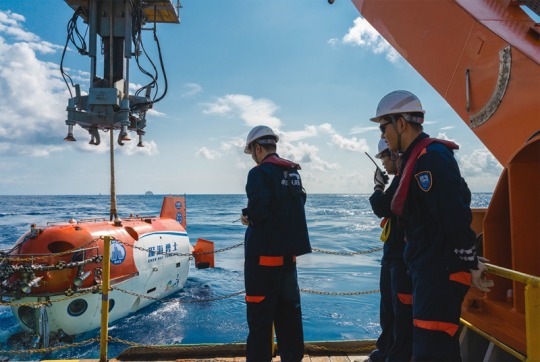

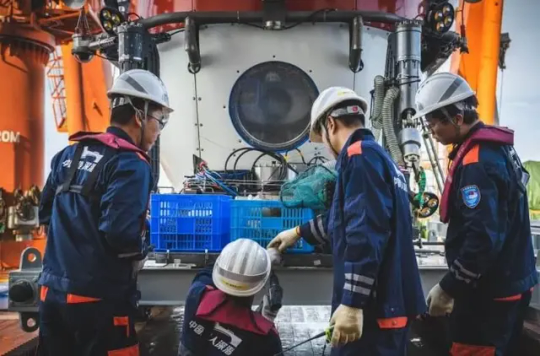
#900 Artifacts From Ming Dynasty Shipwrecks Found in South China Sea#island of Hainan#Ming dynasty#shipwreck#ancient artifacts#archeology#archeolgst#history#history news#ancient history#ancient culture#ancient civilizations#ancient china#chinese history#chinese art#ancient art
794 notes
·
View notes
Text
Tutorial: Importing an existing world into CAW
Note: I did not write this tutorial! I copy/pasted it from here. I just don't have confidence that TS3 websites will remain viable in the long term, so I'm preserving this mostly for my own future reference. But, maybe it will be helpful for other folks like me who aren't very CAW-savvy and just want to make some edits to an existing world in ways that you can't do in-game. The slightly edited original post is pasted behind the cut.
1) Install the world in the usual way in your fresh game folder. If it is a real prerequisite, in that Riverview objects are used in the world, you'll need to install Riverview too. Of course this also goes for Barnacle Bay or any other custom world EA may release separately. This is also a good time to check in your Installed Items whether any "foreign" CC came with it.
2) Start CAW and make a new world. It will ask for a .png, press the … box and you'll get a few 'starters', choose any. Accept all the rest and OK. You don't need to worry about parameters for your world as they will be overwritten later anyway. Save As the new world with a name you will use temporarily, not the definitive name you want to give it. Let's call it Temp.world for now. Close CAW.
3) Open S3PE and browse to the The Sims 3 Create A World Tool\UserToolData\Worlds and you'll find your Temp.world file. Open it.
4) Use Resource->Import->From package… and browse to your The Sims 3\InstalledWorlds and open the world file you want to "import". Accept the default settings for Import, when it asks you to save between packages, say No. It will show a progress bar so you'll know it's done. This may take a while.
5) Sort the resources by Type (click the "header") and find UNKN 0x296A6258 there. If all is well you should have two, one already deleted (struck out), right-click the other and select "Deleted" to delete it too. At the bottom of the file you should have two WPID resources, one already deleted, delete the other too.
6) Use the "close" button in the upper right to close S3PE. It will tell you the package has changed, choose Yes to save the changes. The reason for doing it this way is you'll know it's done when the S3PE window closes. This may take a while.
7) Start the CAW tool and open your Temp.world. Wait until the render window shows you a reasonable picture of something in the world. This may take a while and there is no real progress indication.
8) Right-click on the Temp.world on the left pane (World Layers) and choose Add/Edit description. Make sure the Name and Description fields are filled in. You can use your final name and description here. Also make sure there is a .png for the thumbnail. If there isn't, browse up one of the samples you got earlier or make sure you have one ready. This needs to be in the 24-bit 256x256 format!
9) Save As the world with the final name, let's say Final.world. It will give you a "wait" cursor for a while and then a normal cursor. Don't touch it!! It's not done! Leave the computer to it until a window pops up informing you the world is successfully saved.
The opposite direction is quite simple, just start CAW and use "Export world". It will put a .sims3pack in your The Sims 3\Exports folder. You can take that out and put it in the Download folder and install it as usual.
131 notes
·
View notes
Text
i caved in and bought renoise
also sorry tumblr i constantly delete this because i have way too many mixing hiccups to fix... was being too hasty haha
for a tracker with daw features like track mixers, vst support, automation, filters etc., it's pretty impressive what you can do with it. finally i get to do hq music without having to wrap my head around more conventional daws; i like the inconvenience of modern tracker interfaces myself, actually.
the first time i had to arrange for something hq like this, the biggest obstacle and wake-up call i had to face was the fact that uh, my mixing skills weren't up to snuff. fixing it was a nightmare. biggest thing i didn't know at the time of arranging was that sidechaining the bass was really important, otherwise the bass drum (kick) wouldn't be heard and be overpowered by the bass. this was pointed out to me by a server member of ours, lolwe. they've been mixing for about 7-8 years and counting so they understand it pretty well... and actually the final mix was made just this morning to actually fix the entire mix lol.
other more minor mixing issues were ironed out with eq-ing, which i have a bit of experience of, though it was pointed out by dinebon_, yet another (new!) server member, who was primarily a bassist. they also pointed out some unwanted dissonance i had put in for the arrangement.
i understand that mixing is pretty much subjective and everyone does it differently, but it should be worth pointing out that there are some rookie mistakes that someone like me _can_ make. i may be a good arranger but this mix wouldn't have sounded better if it weren't for people giving me advice and pointers on how to fix things. i definitely think that getting input from a variety of artists who have different strengths helps to put a mix together and give listeners a more comfortable listening experience, so from now on, i'll be at the very least, sidechaining my basslines with the kick for better mixing. sorry if this doesn't sound great for everyone lol
the vst i used on the other hand, has _a lot_ of technical problems.
i think we all here love the sound canvas series of midi synthesizers, but i unfortunately do not have the money to buy the physical hardware (yet), so i stuck to the roland cloud sc vst. god, it is a terrible technical mess...
obviously the sc is sampled beautifully, and is iconic in the video game music world, but how the hell do you mess up a vst _this_ badly? it has _inverted stereo_, which is, a fad from waaaaaay back when. i'm happy i got to simply fix this through audacity but good grief, man. i had to export each instrument one by one just so i could identify which instruments were cancelling themselves out on mono and which ones weren't. genuinely horrifying stuff. there are also the in-built low-end and high-end boosters, but what about the mids? i'm going to assume that it's just a feature of the time but god i honestly wish they added middle frequency knobs. not that i can't fix that with eq post-production, but i'd rather not do that (especially for the main melody) unless if the problem really is a big deal. again, i love the sound canvas, but i wish that the vst were better; the technical problems i had to work with ended up souring the experience. i wish people could actually fix it some day and turn it into something greater. i'll likely use the vst again but i also want to mix in other instrument and sample libraries as well!
in the meantime, this arrange gave me a crave for kirby again. i love kdl3 sm, it is my favorite game of the gb - snes era of games. idk how but jun ishikawa writes these intoxicating songs for kirby and i am just left to rot listening to them. they are waaaayy too good.
41 notes
·
View notes
Text
youtube
THE BEATLES - NEVER BEFORE HEARD RINGO STARR PERSONAL TAPE RECORDINGS FROM 1966 TOUR - SAMPLE CLIP.
Two Philips C-90 cassette tapes and one Philips C-60, two with handwritten labels (very likely in the hand of Ringo Starr) 'INDIA' and 'MAHARESHI' the third with a sticker affixed bearing handwritten label 'MANILLA (sic) INDIA'. All three contain recordings made by Ringo Starr, likely on a personal tape recorder (see here for image of Ringo returning from tour carrying what appears to be a tape recorder), of various events throughout (mostly) 1966. All recordings have very likely never before been published. Approx 248 minutes of recordings across the tapes. At one point Ringo describes the tapes as 'a talking record of our trip to Germany and Japan'. Across the three tapes, which contain hours of candid conversations with The Beatles, Brian Epstein and others within the inner circle during that period, a small selection of 'highlights' includes: - Brian Epstein discussing how to avoid paying tax/import/export charges when leaving Japan. - Numerous humorous interludes with Ringo recording his thoughts on the tours - often in an array of voices. - Band discussions of the set list for the Japan tour. - Recordings from the Budokan concerts (segments of 'If I Needed Someone' and 'Day Tripper') possibly from stage or close to stage itself, seemingly more likely from the band listening back to the recordings, whilst still in Japan. Also John asking Brian Epstein what he thought of the show. - Recordings from Manila inc thoughts on the hotel ‘pretty crappy’. - Extensive recordings from July 1966 whilst in India including the group experimenting with Indian musical instruments. - Extensive recordings of the Maharishi Mahesh Yogi - possibly recorded later than ‘66- approx 38 minutes worth. - Recordings of Ringo solo with piano performing ‘Don’t Pass Me By’, an early version without full lyrics. - Recordings of Ringo at piano performing two likely unreleased demos - one with refrain ‘have you seen the tulips grow’ and one seemingly a version of 'I Bought A Picasso' Provenance: purchased by the vendor as part of a collection of Beatles memorabilia. By repute - the original owner had been an acquaintance of Ringo Starr during the 1960s. Accompanied by CDs containing copies of recordings.
39 notes
·
View notes
Text
Spore multi-legged animation import finding
So, if you guys ever installed my or Mx3's dance mods, you'll notice that the animation for creatures with more than 2 legs tend to mess up especially when the creature spin around to any orientation that isn't straightforward. As seen here:
youtube
youtube
This is because most available animations out there are made for bipedal humanoid models, and does not take into account of multi legged rigs. This cause for the legs in positions far away from the body to not move to the new positions the torso has rotated to.
However, as you can see with vanilla Test Drive animations such as Hippity Hop, Flowers, Space Walk, these are work with creatures with different leg configurations. So how do they do that?
This is because instead of moving just the Root bone of the creature, they also move the Creature Frame. And naturally, the legs/feet are coded to move accordingly to this frame. But this is isn't the case however if the legs animation info keyframe has -flags 0x2. This cause the leg to simply animate as programmed without trying to accommodate to the Creature Frame.
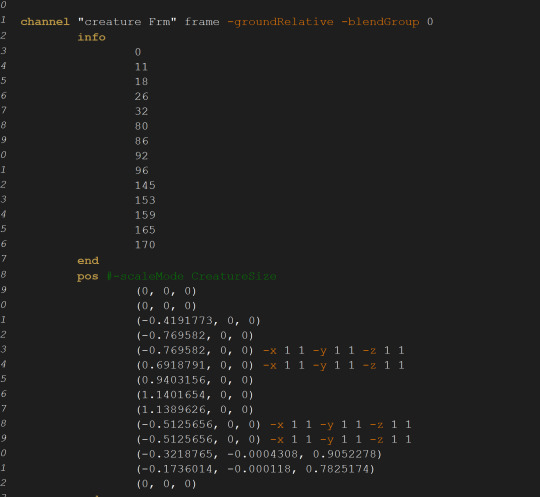

And from what I found: the Creature Frame bone is responsible for the XY translation of the creature, and most of Z rotation, while the root bone is responsible for the Z translation and XY rotation a bit of the Z rotation (we'll get to that later). the other parts also function the same way as the root bone.
So now the question is, how do you turn a bipedal animation you found online into a Spore's animation that fits for most multi legged models?
While there are many ways I can approach this, I chose to use the Blender hip bone to drive the Spore Creature Frame XY translation and Z rotation, and the other animations will be adjusted to animate only in reference of that creature frame bone. This last part is difficult because the math is quite complex. But luckily, the Bone Constraints in blender has an option to use frame of reference.
What I did was making multiple dummy bones (green - because they have bone constraints) that animate similar to the absolute position of the model, but only in reference of the creature frame.
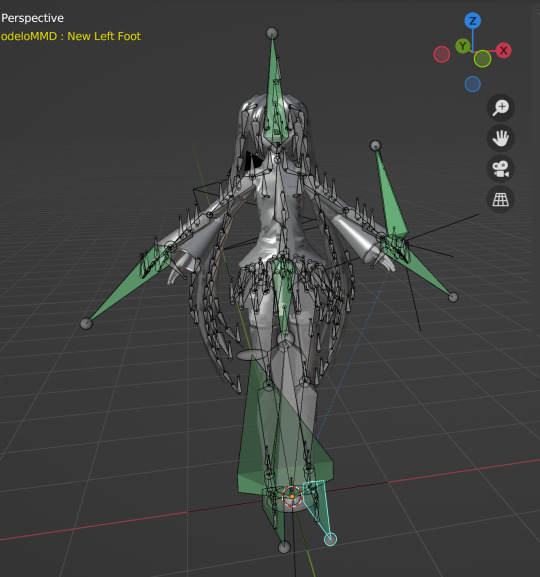
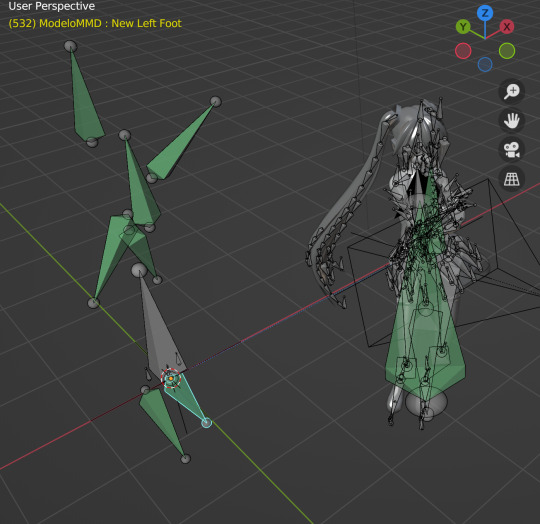
The bone constraints look like this (example: left feet):
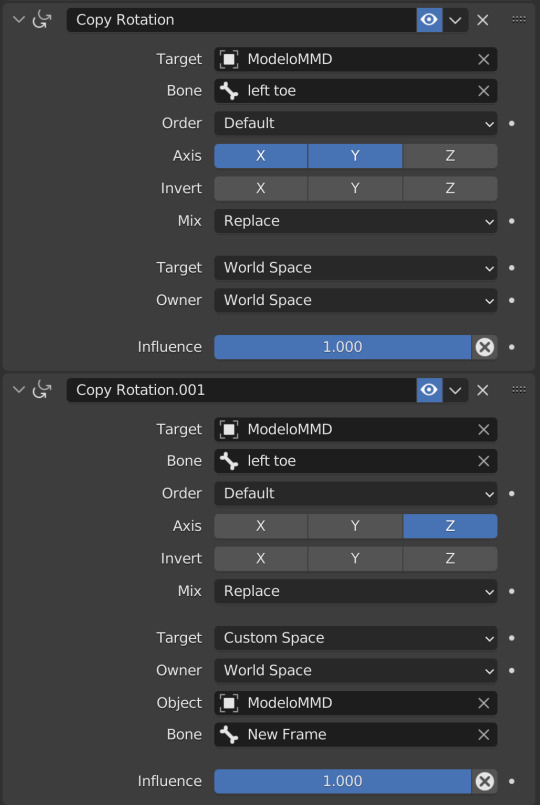
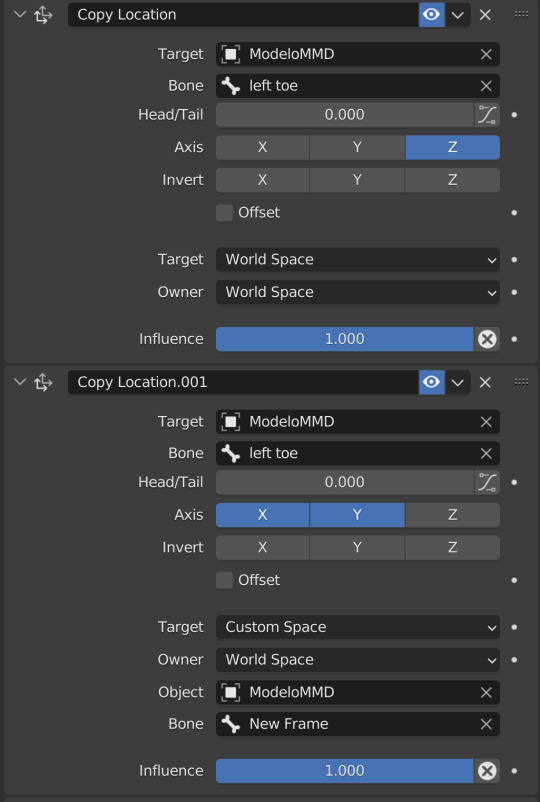
Now, in order to export my animation, I choose the convention of animating the front legs with the -flags 0x2 in order to allow them to be more expressive and normal, while the hind legs don't have that so they will adapt to the creature's frame. And if you put the animation channel of the front legs before the hind legs, it will be used as the default when your creature only has 2 legs.
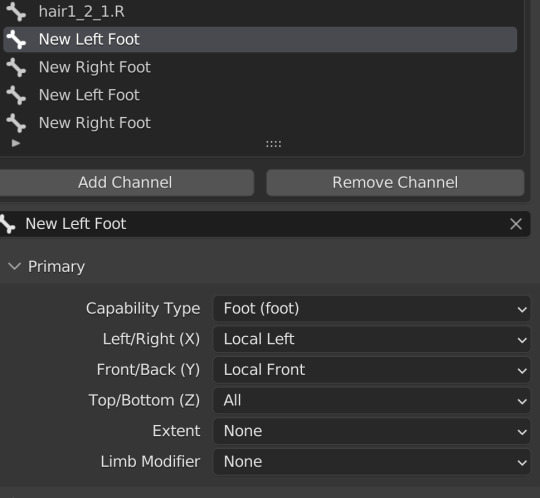
And the result is this:
youtube
youtube
As you can see, it's a lot better, but still tend to jerk a bit. This I think is because I attribute all of the Z rotation to the Creature Frame. While likely what happened in vanilla animation, the Creature Frame is only attributed to large changes/ low update frequency animation, while the root and other bones is in charged of smaller changes/rapid animations, but I haven't figured out how to do that yet.
Note: I've also used this technique to adapt the camera motion as well, and while it looks relatively similar to the original camera I imported, it jerk quite a bit because of the jerking of the body.
Here's a sample project with the animation, camera effect and sound if people wanna play with:
And here's the Blender file if anyone wanna have a crack at trying to improve it. Note: this file is easier to work with if you have the MMD Tools, CATS and Retarget Helper Blender Add-on (The Blender version I'm using is 3.2.2):
Have fun and good luck modding Spore!
#Ramone's Artery#Spore#Spore creations#Spore creatures#Spore galactic advaenture#animation#effect#artist on tumblr#Ramone's Thots#modding#gaming#Youtube
12 notes
·
View notes
Photo

[ A critically endangered European eel, photo credited to Kristen Steele. ]
“DNA testing has confirmed widespread – and probably illegal – international trading of critically endangered European eels.
A research team led by the University of Exeter carried out “DNA barcoding” on products including jellied eels and unagi, which is used in sushi and donburi.
With European eel populations at about 5-10% of their former levels, the EU has banned the import and export of European eels.
This has sparked a highly lucrative illegal trade – with media reports of a “multi-billion pound eel mafia”. In June 2022, European authorities announced the arrest of 49 people involved in a trafficking network that moved live eels in suitcases.
The researchers analysed 114 samples and combined their results with existing published research, finding European eels – and endangered American and Japanese eels – on sale in the UK, Continental Europe, North America and Asia.
“The growing popularity of Japanese cuisine worldwide has caused an increasing demand for freshwater eels,” said Dr Andrew Griffiths, from the University of Exeter.
“The complex lifecycle of these eels – which includes migrating from rivers to spawn in the sea – means they cannot be bred at large scale in captivity.
“So the illegal trade involves catching young eels in Europe, transporting them to East Asia and growing them on in fish farms.”
The new study tested eel-based foods in North America and Europe. About 40% of North American unagi samples they analysed contained European eel.”
- Excerpt from “DNA testing finds endangered eels on the menu” by Alex Morrison.
132 notes
·
View notes
Text
British presence in the Straits Settlements […] (Penang, Singapore and Melaka) as a whole opened the way […]. Governor Andrew Clarke [...] clearly intended that economic botany should follow the quest for tin. Hardly three months after the [signing of the treaty legitimising British control in Malaya] [...] the Governor pressed Lord Carnarvon, Secretary of State for the Colonies, himself a keen botanist and collector, for the services of a ‘scientific botanist’. [...] Intimate plant knowledge among local [people] [...] assisted the discovery of many [plants valuable to European empire] [...] and the absorption of a number of vernacular names such as kempas (Koompassia), pandan (Pandanus) and nipah (Nypa) into scientific nomenclature. Equally, indigenous names for timbers, pre-eminently meranti and cengal, attained the status of trade names on the international market. Malay knowledge [...] proved also invaluable for commerce and [...] industries.
The Great Exhibition of 1851 at the Crystal Palace in Hyde Park, which displayed representative samples of colonial resources, was a microcosm of empire. Empire [...] co-sponsored the surveying, mapping and inventorying of people, lands and products for the ends of imperial power. Tropical nature, once a source [...] of wonderment, was brought to the domestic market place.
High on the imperial economic agenda were the Malayan territories, the source of gutta percha (from Palaquium gutta). Ingeniously adapted by the Malays [...], the plastic qualities of gutta percha were investigated for medical and industrial use by the [English East India] Company surgeons, T. Mongtomerie (1819-43) and T. Oxley (1846-57). [...] At the same time Oxley successfully pioneered the use of gutta percha for plastering fractures and preserving vaccine, the latter hitherto unable to be kept even for a few days. When a Prussian artillery Officer [...] then perfected its use for insulating telegraph cables, the product immediately gained strategic importance for the empire. Similar adaptations of other indigenous uses of plants paid dividends to industry and agriculture. [...]
---
The emergence of Hevea rubber in the Peninsula, superseding gutta percha as an industrial product was, again, the result of scientific exchange within the close-knit colonial botanical network [...] [following] [t]he illegal exportation by Kew [Royal Botanic Gardens in London] of the seedlings from South America to Ceylon and the Singapore Botanic Gardens [...]. Out of the seedlings sent in 1877 to Singapore, seven were planted by Hugh Low in the Perak Residency Garden. These and those raised in the Botanic Gardens furnished the seeds for the first plantations.
Though an introduced species, indigenous knowledge [...] of a wide variety of gums and exudates [...] benefited the plantation industry.
This [...] scored a major triumph for the colonial plantation industry. [...]
Large areas of Melaka had already been laid to waste by [...] a fast-growing variety of Brazilian cassava introduced in 1886 by Cantley.
The same cultivators soon turned the Imperata grasslands to rubber, but its rapid spread meant that a number of native plant species either became very rare or were entirely exterminated. The wild ancestor of the domestic mangosteen (Garcinia mangostana) is a likely example. [...] During his visit to Singapore in 1854 Wallace identified, within just a square mile, some 700 species of beetles [...].
---
All text above by: Jeyamalar Kathirithamby-Wells. "Peninsular Malaysia in the context of natural history and colonial science." New Zealand Journal of Asian Studies Volume 11 Number 1. 2009. [Bold emphasis and some paragraph breaks/contractions added by me. Presented here for commentary, teaching, criticism purposes.]
#abolition#ecology#plantations#imperial#colonial#tidalectics#extinction#archipelagic thinking#victorian and edwardian popular culture#intimacies of four continents#malaya plantations
64 notes
·
View notes
Text



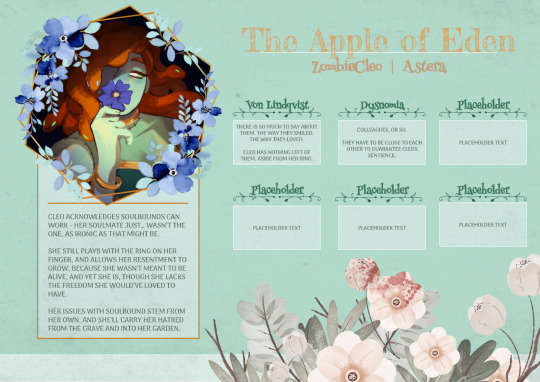
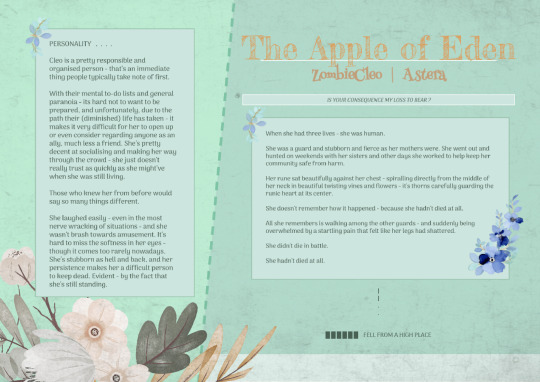




🥀⸝⸝ ♡︎﹒LEAVE MY CORPSE TO ROT " 』 . . . RP Template ! ─── Free to use (with credit!)
It's been a while since I made another sheet, and tbh - I felt a bit rusty haha. Hopefully I'll be able to get back into it full swing sometime, though it'll depend when the next RP servers I make open up.
Anyway this one's been really fun! I love flower themes and I kind of really wanna try something out of my comfort zone soon but I'm not sure what yet. Ah well!
I also wanted to put here again the ZCleo artwork I used are not mine! Here's the links to the artists if you would like to check them out! ♡
[ wormtime123 ] [ redIifes ]

Instructions on how to edit below.

Notes :
I've made this as easy to customise as possible for those without image editing programs!
But some parts may still require it! (ie - the img on page 3)
[ Important ] This sheet uses a lot of Google Drawing elements! They are not editable on MOBILE (let me know if i'm wrong).
In fact like 70% of the text boxes are Google Drawings. Some of the photos are Google Drawings to allow you to replace images with your own easier!
[ Important ] Some images have been layered with effects/frames that make it so you can't access the text boxes underneath it! Simply right click the frame/item/etc, go to 'Order' and then 'Send to Back' in order to access what you need! Send it to the front again when you're done.

Please make your own copy of the sheet! Do not send me requests to give you permission to edit the sheet! Making a copy will give you your very own version to edit! pls guys my email-
How to get your own copy [DESKTOP] ・Open the link ・Click on the 'File' button on the top left ・Click on 'Make a Copy' ・Name the file, and click 'Make a Copy' ・You can now edit your own copy!
How to get your own copy [MOBILE] ・Open the link on your Docs app ・Tap on the 3 dots on the top right ・Tap on 'Share and Export' ・Tap 'Make a Copy' and name the file! ・You can now edit your own copy!

How to edit . . .
Images! - [ DESKTOP ] Right click on the placeholder image and select 'Replace with' and choose your downloaded image. - [ MOBILE ] Tap on the image, and at the bottom there should be an image icon. Tap on that to look for the new image you want to use.
Google Drawings! [ Not Possible on Mobile ] [ This makes up a big portion of the texts and images on the sheet ] Double click on the Google Drawing. - Or you can click on the Google Drawing, and then click on the Pencil icon to edit it.
Some Google Drawings have been layered with frames,images,etc to make it look pretty - but blocks access to the text boxes under it. In order to access them - right click the item thats blocking you from accessing the text box/image and go to 'Order' and then 'Send to Back'. When you're done - just go to 'Order' and then 'Send to Front' again to put it back into place!

♡ Let me know what you think! ♡
#roleplay#google docs#google docs template#rp template#rp doc#roleplay doc#rp#rp resources#character sheet#google doc templates#google doc#muse template#discord rp template#oc template#docs template#gdocs template#rp doc template#zombiecleo#tai post#tai template
287 notes
·
View notes
Text
SHANGHAI — Over the past generation, China’s most important relationships were with the more developed world, the one that used to be called the “first world.” Mao Zedong proclaimed China to be the leader of a “third” (non-aligned) world back in the 1970s, and the term later came to be a byword for deprivation. The notion of China as a developing country continues to this day, even as it has become a superpower; as the tech analyst Dan Wang has joked, China will always remain developing — once you’re developed, you’re done.
Fueled by exports to the first world, China became something different — something not of any of the three worlds. We’re still trying to figure out what that new China is and how it now relates to the world of deprivation — what is now called the Global South, where the majority of human beings alive today reside. But amid that uncertainty, Chinese exports to the Global South now exceed those to the Global North considerably — and they’re growing.
The International Monetary Fund expects Asian countries to account for 70% of growth globally this year. China must “shape a new international system that is conducive to hedging against the negative impacts of the West’s decoupling,” the scholar and former People’s Liberation Army theorist Cheng Yawen wrote recently. That plan starts with Southeast Asia and extends throughout the Global South, a terrain that many Chinese intellectuals see as being on their side in the widening divide between the West and the rest.
“The idea is that what China is today, fast-growing countries from Bangladesh to Brazil could be tomorrow.”
China isn’t exporting plastic trinkets to these places but rather the infrastructure for telecommunications, transportation and digitally driven “smart cities.” In other words, China is selling the developmental model that raised its people out of obscurity and poverty to developed global superpower status in a few short decades to countries with people who have decided that they want that too.
The world China is reorienting itself to is a world that, in many respects, looks like China did a generation ago. On offer are the basics of development — education, health care, clean drinking water, housing. But also more than that — technology, communication and transportation.
Back in April, on the eve of a trip to China, Brazilian President Luiz Inacio Lula da Silva sat down for an interview with Reuters. “I am going to invite Xi Jinping to come to Brazil,” he said, “to get to know Brazil, to show him the projects that we have of interest for Chinese investment. … What we want is for the Chinese to make investments to generate new jobs and generate new productive assets in Brazil.” After Lula and Xi had met, the Brazilian finance minister proclaimed that “President Lula wants a policy of reindustrialization. This visit starts a new challenge for Brazil: bringing direct investments from China.” Three months later, the battery and electric vehicle giant BYD announced a $624 million investment to build a factory in Brazil, its first outside Asia.
Across the Global South, fast-growing countries from Bangladesh to Brazil can send raw materials to China and get technological devices in exchange. The idea is that what China is today, they could be tomorrow.
At The Kunming Institute of Botany
In April, I went to Kunming to visit one of China’s most important environmental conservation outfits — the Kunming Institute of Botany. Like the British Museum’s antiquities collected from everywhere that the empire once extended, the seed bank here (China’s largest) aspires to acquire thousands of samples of various plant species and become a regional hub for future biotech research.
From the Kunming train station, you can travel by Chinese high-speed rail to Vientiane; if all goes according to plan, the line will soon be extended to Bangkok. At Yunnan University across town, the economics department researches “frontier economics” with an eye to Southeast Asian neighboring states, while the international relations department focuses on trade pacts within the region and a community of anthropologists tries to figure out what it all means.
Kunming is a bland, air-conditioned provincial capital in a province of startling ethnic and geographic diversity. In this respect, it is a template for Chinese development around Southeast Asia. Perhaps in the future, Dhaka, Naypyidaw and Phnom Penh will provide the reassuring boredom of a Kunming afternoon.
Imagine you work at the consulate of Bangladesh in Kunming. Why are you in Kunming? What does Kunming have that you want?
The Bengali poet Rabindranath Tagore lyrically described Asia’s communities as organic and spiritual in contrast with the materialism of the West. As Tagore spoke of the liberatory powers of art, his Chinese listeners scoffed. The Chinese poet Wen Yiduo, who moved to Kunming during World War II and is commemorated with a statue at Yunnan Normal University in Kunming, wrote that Tagore’s work had no form: “The greatest fault in Tagore’s art is that he has no grasp of reality. Literature is an expression of life and even metaphysical poetry cannot be an exception. Everyday life is the basic stuff of literature, and the experiences of life are universal things.”
“Xi Jinping famously said that China doesn’t export revolution. But what else do you call train lines, 5G connectivity and scientific research centers appearing in places that previously had none of these things?”
If Tagore’s Bengali modernism championed a spiritual lens for life rather than the materiality of Western colonialists, Chinese modernists decided that only by being more materialist than Westerners could they regain sovereignty. Mao had said rural deprivation was “一穷二白” — poor and empty; Wen accused Tagore’s poetry of being formless. Hegel sneered that Asia had no history, since the same phenomena simply repeated themselves again and again — the cycle of planting and harvest in agricultural societies.
For modernists, such societies were devoid of historical meaning in addition to being poor and readily exploited. The amorphous realm of the spirit was for losers, the Chinese May 4th generation decided. Railroads, shipyards and electrification offered salvation.
Today, as Chinese roads, telecoms and entrepreneurs transform Bangladesh and its peers in the developing world, you could say that the argument has been won by the Chinese. Chinese infrastructure creates a new sort of blank generic urban template, one seen first in Shenzhen, then in Kunming and lately in Vientiane, Dhaka or Indonesian mining towns.
The sleepy backwaters of Southeast Asia have seen previous waves of Chinese pollinators. Low Lan Pak, a tin miner from Guangdong, established a revolutionary state in Indonesia in the 18th century. Li Mi, a Kuomintang general, set up an independent republic in what is now northern Myanmar after World War II.
New sorts of communities might walk on the new roads and make calls on the new telecom networks and find work in the new factories that have been built with Chinese technology and funded by Chinese money across Southeast Asia. One Bangladeshi investor told me that his government prefers direct investment to aid — aid organizations are incentivized to portray Bangladesh as eternally poor, while Huawei and Chinese investors play up the country’s development prospects and bright future. In the latter, Bangladeshis tend to agree.
“Is China a place, or is it a recipe for social structure that can be implemented generically anywhere?”
The majority of human beings alive today live in a world of not enough: not enough food; not enough security; not enough housing, education, health care; not enough rights for women; not enough potable water. They are desperate to get out of there, as China has. They might or might not like Chinese government policies or the transactional attitudes of Chinese entrepreneurs, but such concerns are usually of little importance to countries struggling to bootstrap their way out of poverty.
The first world tends to see the third as a rebuke and a threat. Most Southeast Asian countries have historically borne abuse in relationship to these American fears. Most American companies don’t tend to see Pakistan or Bangladesh or Sumatra as places they’d like invest money in. But opportunity beckons for Chinese companies seeking markets outside their nation’s borders and finding countries with rapidly growing populations and GDPs. Imagine a Huawei engineer in a rural Bangladeshi village, eating a bad lunch with the mayor, surrounded by rice paddies — he might remember the Hunan of his childhood.
Xi Jinping famously said that China doesn’t export revolution. But what else do you call train lines, 5G connectivity and scientific research centers appearing in places that previously had none of these things?
Across the vastness of a world that most first-worlders would not wish to visit, Chinese entrepreneurs are setting up electric vehicle and battery companies, installing broadband and building trains. The world that is looming into view on Huawei’s 2022 business report is one in which Asia is the center of the global economy and China sits at its core, the hub from which sophisticated and carbon-neutral technologies are distributed. Down the spokes the other way come soybeans, jute and nickel. Lenin’s term for this kind of political economy was imperialism.
If the Chinese economy is the set of processes that created and create China, then its exports today are China — technologies, knowledge, communication networks, forms of organization. But is China a place, or is it a recipe for social structure that can be implemented generically anywhere?
Huawei Station
Huawei’s connections to the Chinese Communist Party remain unclear, but there is certainly a case of elective affinities. Huawei’s descriptions of selfless, nameless engineers working to bring telecoms to the countryside of Bangladesh is reminiscent of Party propaganda and “socialist realist” art. As a young man, Ren Zhengfei, Huawei’s CEO, spent time in the Chongqing of Mao’s “third front,” where resources were redistributed to develop new urban centers; the logic of starting in rural areas and working your way to the center, using infrastructure to rappel your way up, is embedded within the Maoist ideas that he studied at the time. Today, it underpins Huawei’s business development throughout the Global South.
I stopped by the Huawei Analyst Summit in April to see if I could connect the company’s history to today. The Bildungsroman of Huawei’s corporate development includes battles against entrenched state-owned monopolies in the more developed parts of the country. The story goes that Huawei couldn’t make inroads in established markets against state-owned competitors, so got started in benighted rural areas where the original leaders had to brainstorm what to do if rats ate the cables or rainstorms swept power stations away; this story is mobilized today to explain their work overseas.
Perhaps at one point, Huawei could have been just another boring corporation selling plastic objects to consumers across the developed world, but that time ended definitively with Western sanctions in 2019, effectively banning the company from doing business in the U.S. The sanctions didn’t kill Huawei, obviously, and they may have made it stronger. They certainly made it weirder, more militant and more focused on the markets largely scorned by the Ericssons and Nokias of the world. Huawei retrenched to its core strength: providing rural and remote areas with access to connectivity across difficult terrain with the intention that these networks will fuel telehealth and digital education and rapidly scale the heights of development.
Huawei used to do this with dial-up modems in China, but now it is building 5G networks across the Global South. The Chinese government is supportive of these efforts; Huawei’s HQ has a subway station named for the company, and in 2022 the government offered the company massive subsidies.
“For many countries in the Global South, the model of development exemplified by Shenzhen seems plausible and attainable.”
For years, the notion of an ideological struggle between the U.S. and China was dismissed; China is capitalist, they said. Just look at the Louis Vuitton bags. This misses a central truth of the economy of the 21st century. The means of production now are internet servers, which are used for digital communication, for data farms and blockchain, for AI and telehealth. Capitalists control the means of production in the United States, but the state controls the means of production in China. In the U.S. and countries that implicitly accept its tech dominance, private businesspeople dictate the rules of the internet, often to the displeasure of elected politicians who accuse them of rigging elections, fueling inequality or colluding with communists. The difference with China, in which the state has maintained clear regulatory control over the internet since the early days, couldn’t be clearer.
The capitalist system pursues frontier technologies and profits, but companies like Huawei pursue scalability to the forgotten people of the world. For better or worse, it’s San Francisco or Shenzhen. For many countries in the Global South, the model of development exemplified by Shenzhen seems more plausible and attainable. Nobody thinks they can replicate Silicon Valley, but many seem to think they can replicate Chinese infrastructure-driven middle-class consumerism.
As Deng Xiaoping said, it doesn’t matter if it is a black cat or a white cat, just get a cat that catches mice. Today, leaders of Global South countries complain about the ideological components of American aid; they just want a cat that can catch their mice. Chinese investment is blank — no ideological strings attached. But this begs the question: If China builds the future of Bangladesh, Indonesia, Pakistan and Laos, then is their future Chinese?
Telecommunications and 5G is at the heart of this because connectivity can enable rapid upgrades in health and education via digital technology such as telehealth, whereby people in remote villages are able to consult with doctors and hospitals in more developed regions. For example, Huawei has retrofitted Thailand’s biggest and oldest hospital with 5G to communicate with villages in Thailand’s poor interior — the sort of places a new Chinese high-speed train line could potentially provide links with the outside world — offering Thai villagers without the ability to travel into town the opportunity to get medical treatments and consultations remotely.
The IMF has proposed that Asia’s developing belt “should prioritize reforms that boost innovation and digitalization while accelerating the green energy transition,” but there is little detail about who exactly ought to be doing all of that building and connecting. In many cases and places, it’s Chinese infrastructure and companies like Huawei that are enabling Thai villagers to live as they do in Guizhou.
Chinese Style Modernization?
The People’s Republic of China is “infinitely stronger than the Soviet Union ever was,” the U.S. ambassador to China, Nicholas Burns, told Politico in April. This prowess “is based on the extraordinary strength of the Chinese economy — its science and technology research base, its innovative capacity and its ambitions in the Indo-Pacific to be the dominant power in the future.” This increasingly feels more like the official position of the U.S. government than a random comment.
Ten years ago, Xi Jinping proposed the notion of a “maritime Silk Road” to the Indonesian Parliament. Today, Indonesia is building an entirely new capital — Nusantara — for which China is providing “smart city” technologies. Indonesia has a complex history with ethnic Chinese merchants, who played an intermediary role between Indigenous people and Western colonists in the 19th century and have been seen as CCP proxies for the past half century or so. But the country is nevertheless moving decisively towards China’s pole, adopting Chinese developmental rhythms and using Chinese technology and infrastructure to unlock the door to the future. “The internet, roads, ports, logistics — most of these were built by Chinese companies,” observed a local scholar.
The months since the 20th Communist Party Congress have seen the introduction of what Chinese diplomats call “Chinese-style modernization,” a clunky slogan that can evoke the worst and most boring agitprop of the Soviet era. But the concept just means exporting Chinese bones to other social bodies around the world.
If every apartment decorated with IKEA furniture looks the same, prepare for every city in booming Asia to start looking like Shenzhen. If you like clean streets, bullet trains, public safety and fast Wi-Fi, this may not be a bad thing.
Chinese trade with Southeast Asia is roughly double that between China and the U.S., and Chinese technology infrastructure is spreading out from places like the “Huawei University” at Indonesia’s Bandung Institute of Technology, which plans to train 100,000 telecom engineers in the next five years. We’re about to see a generation of “barefoot doctors” throughout Southeast Asia traveling by moped across landscapes of underdevelopment connected to hubs of medical data built by Chinese companies with Chinese technology.
In 1955, the year of the Bandung Conference in Indonesia, the non-aligned world was almost entirely poor, cut off from the means of production in a world where nearly 50% of GDP globally was in the U.S. Today, the logic of that landmark conference is alive today in Chinese informal networks across the Global South, with the key difference that China can now offer these countries the possibility of building their own future without talking to anyone from the Global North.
Welcome to the Sinosphere, where the tides of Chinese development lap over its borders into the remote forests of tropical Asia, and beyond.
60 notes
·
View notes
Text

Marvel Decades Fanfic -1984
The Set-up
200 million years ago the alien race the Nuwali created the Savage Lands in Antarctica as one of several planetary “game preserves” for the mysterious godlike Beyonders. The Nuwali stocked the land with earthly life of the era, most notably dinosaurs; as Earth’s flora and fauna changed over succeeding millions of years. When the dinosaurs went extinct over 65 million years ago, the only survivors were the ones living in this protected area at the bottom of the globe.
In 18,500 BC the Savage Lands were colonized by humans of Atlantis, who exported prehistoric life throughout their empire while importing Unicorns and other mystic creatures. Atlantean scientists extended the tropical effect, creating a recreation/commerce center called “Pangea”, then genetically altered man-apes into humanoid versions of birds, monkeys, fish, and other animals. The Beast-Men were put to work as laborers. The Beast-Men however became dissatisfied with servitude and Pangea’s automation, rebelled in the 1st Pangean War and were allowed to colonize unpopulated areas rendered habitable by the Nuwali Tropical Effect.
In the Mid-19th century, The Atlanteans - That is the underwater race of mutants whose culture was appropriated from Atlantis’ remains - relocated to Antarctica, as did Lemurian rebels called The Ancients. Mysterious beings such as Torg and The Ice King also made their home in the region. Vague reports of underground realms and surviving dinosaurs appeared in the works of such authors as Edgar Allen Poe, H.P. Lovecraft, and Jules Verne, suggesting rumors of the lands were spreading. By 1915, human expeditions had discovered a rare type of destructive Vibranium called “Anti-Metal”, the destructive metal also called Vibranium, in the Savage Land, but the greater deposits within the lands remained unknown. During WWII, Hitler claimed sovereignty over Antarctica and several entire battalions of his men were lost to the realm on expeditions. Meanwhile, spatial warps similar to that of the Bermuda Triangle, occasionally brought ships and planes into the lands, where survivors joined the populace. In more recent history, the British nobleman Robert Plunder, searching for Vibranium, found his way into the Savage Lands. Back in England, Plunder was threatened by those who coveted his secret, and he returned to the lands with his nine-year-old son Kevin, who was orphaned when Robert was slain by the Man-Ape, Maa-Gor. Nurtured by the Sabertooth Tiger Zabu, Kevin enhanced by the lands mysterious “Place of Mists” became known as Ka-Zar, or “Brother of the Tiger”, his uncanny skills ans heroism won him respect throughout the land while still in his teens. Ka-Zar was photographed while exploring the northern limits, provoking investigation by the mutant X-Men, whom he befriended. When the X-Men’s nemesis, Magneto, took the land as his base and transformed simple swamp men into his Savage Land Mutates, Ka-Zar helped the X-Men defeat their old foe, and then fought alongside Garokk against the renegade priestess Zaladane. The land, so long once a source of rumor, became worldwide news when thr Daily Bugle ran a featufe on it, an endeavour that brought the heroic Spider-Man to the lands, where he aided Ka-Zar against another would-be dictator, Kraven The Hunter. Soon afterwards, Ka-Zar provided SHIELD scientists with dinosaur samples which were misuses by a reaearcher who, with the aid of the cryptic They Who Wield Power, transformed himself into Stegron, The Dinosaur-Man. Although the United Nations banned commercial exploitation of the Savage Lands, the Daily Bugle’s exposure brought explorers and treasure hunters to Ka-Zar’s door. Ka-Zar, now in Shanna The She-Devil’s company, explored Pangea and helped establish peace between its many races. The Savage Lands were eventually declared a sovereign kingdom, and although menaced by myriad would-be conquerors –including Apocalypse, a Super-Skrull, Prime Evil, The Warlord, Sauron, Mister Sinister, The High Evolutionary, and AIM– hit's security was repeatedly restored by Ka-Zar, the X-Men, and other heroes.
-
Frank Castle, better known as The Punisher, had discovered Vibranium-B or SLV developed into highly destructive weaponry in use in the streets of New York by gangsters and had questioned the culprits of their arsenal's origins. Tracking the supply chain back to Wilson Fisk (Kingpin), The Punisher was then manipulated into traveling to a remote region of Antarctica to seek out and shut down manufacturing operations and prevent any further lethal misuse of the anti-metal.
-
The notorious and infamous mutant mercenary with a mouth, DeadPool, and lady luck herself, Domino, had been summoned by the executive branches of both Roxxon Oil & Energy as well as A.I.M. (Advanced Idea Mechanics) to discuss employment. The corporations sought experts and professionals with talents such as theirs to shut down any preestablished Vibranium-B mines and claim any mineral rich sites on behalf of the companies.
-
Members of a secret society, whispered in conspiracy theories to be known as 'The Illuminati', convened over a shared and vested interest in the discovery of the precious mineral as scientists and to prevent the Vibranium-B from falling into the wrong hands. T'Challa the king and Black Panther of Wakanda, Reed Richards (Mr. Fantastic) of The Fantastic Four, and Henry 'Hank' McCoy (Beast) of the X-Men had voted to intervene in the unfolding affairs.
----to be cont.d
#marvel#marvel comics#marvel characters#comic books#marvel fanfiction#marvel fanfic series#l1t3rat1#marvel fanfic#my fanfiction#fanfiction#the savage land#ka zar#shanna the she devil#mr fantastic#black panther#beast#the punisher#deadpool
3 notes
·
View notes
Note
your gifs are always so crisp and clear. how do you make the magic happen??
thank you! i i've answered this question before but my process has changed a little since then so here's an update!
first and foremost, i start with the highest quality video possible. i only work with 1080p or higher, and the largest file size i can find.
once i've picked my scene(s) and imported the files into photoshop, i always follow the same flow: crop | color | sharpen | tweak | export.
i won't go into too much detail about color but one thing to keep in mind is that it's likely you will lose quality with drastic color adjustments. i prefer to make several minor adjustments as opposed to drastic changes because they're much easier to undo if you find you've lost your way. i use the eyedropper tool and/or the individual color sliders on my base layers (levels and curves) on almost every gif. these layers do a lot of heavy lifting to even out coloring (curves are especially helpful in decreasing the yellow/orange hue that is so common in a lot of media these days). then i follow up with a combination of contrast, exposure, channel mixer, selective color, hue/sat and vibrance, as needed. i hand color all of my gifs so the layers i use vary greatly from gif to gif. in the sample pics i've included below, you will see that the only color layer i used is hue/sat. the rest of my color adjustments were made in the first curves layer. i'm also using a gradient map to adjust the background color of the scene, which is important to keep in mind when you're doing your coloring.
next up, sharpening! i use the sharper action in this pack as a base, which applies two layers of smart sharpening. next i add a high pass filter (filter | other | high pass) which i think adds an additional pop of refinement to a gif on top of the smart sharpening. you can read all about high pass here. i typically use a radius between .5 and 1.0, then set the blending to soft light. finally i add a noise reduction layer (filter | noise | reduce noise), set the strength 3-5 and preserve details to 15-20. i usually set the opacity of this layer to 40-60% but again, it varies from gif to gif. i know some other gifmakers who like to add a gaussian blur at this stage instead, so i'd suggest playing around with both settings to find what works best for you.
and that's basically it! i may make a few color or brightness tweaks to the final gif but otherwise it's ready for export.
here's a look at my layers panel and a frame from a gif i'm working on for an upcoming set at various stages in the process.
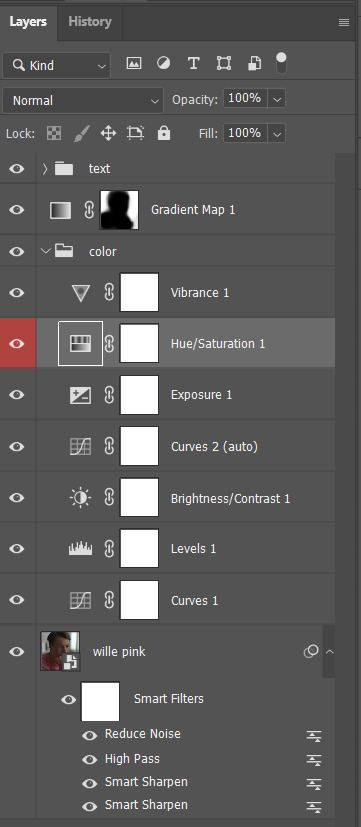




this all may feel like a lot of steps but once you figure out what works for you, it becomes second nature and part of the fun. sorry for the delay in answering and thanks for the ask! feel free to message me again if something isn't clear. 💜
9 notes
·
View notes
Text
📁 Primitive UTAU Recording Method . . .

To end the recording section, I would like to discuss and talk about early methods to recording and configuring an UTAU on MacOS. It is important for me to add because Hakken was the last UTAU I had configured this way before learning any new methods.
For perspective, I started doing UTAU activities on MacOS 6 years ago as of writing this! So there wasn't a whole lot to work with back then besides Audacity and UTAU-Synth. Now we have programs such as Recstar, Vlabeler, and OpenUTAU.
Now, I would like to talk about Hakken's development and how he was recorded for this next segment. Disclaimer, this method is NOT recommended as it is very tedious. For Hakken, he was recorded on Voice Memos on iOS, the memo was exported as an m4a, then converted into a WAV. The WAV of continuous recordings were then split into CV-VV format in Audacity, and then he was configured on UTAU-Synth!
For perspective, here is my old recording list opened alongside the Voice Memo application.

Voice memos is the default recording software for iOS, but you can also use this to record your samples. Here in the screenshot I am using the iOS splitview to multitask the recordings and the reclist. To do this, I imported the recording list into the notes app.
This is what life would be like without Recstar! But since Hakken and Ron's *( Ron's now discontinued ) banks are configured this way, it feels important to mention.
2 notes
·
View notes